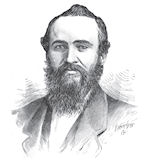
Saturday, 28th.—According to previous instructions (see under 25th instant), Col. Rains, with his regiment, McNairy’s Battalion and Falcond’s section of artillery, moved out from Barboursville in the direction of Laurel Bridge, while Colonel Cummings, with his detachment and about fifty wagons, moved out for the Salt Works, and Colonel Statham moved so as to support either of the other detachments if necessary.
Colonel McNairy was ordered to take the advance with Harris’s, Payne’s and Allison’s Companies. Our Colonel had not gone far along the London road before he threw out flankers as well as an advance guard, with instructions to keep a sharp lookout for the enemy. Thus, we moved on without any incident worthy of note until we struck the enemy’s picket, within three miles of their camp. Our advance guard captured three of their picket and chased the rest (six or eight) into camp. Colonel McNairy then fell back a short distance, sent a messenger to meet Colonel Rains, and awaited his arrival with the infantry and artillery. As soon as Rains caught up, the command moved on again with McNairy’s three companies still in front. We met a citizen who said that the enemy was lying in wait for us. So we thought that we would sure have our first engagement, then and there. Before reaching the enemy’s camp, Colonel McNairy was ordered to halt, and Colonel Rains took the advance with his regiment, leaving orders for McNairy to hold his battalion well in hand, ready to pursue if he (Rains) should succeed in routing them. On reaching, the Federal camp, and finding it deserted, Rains’ men raised a war-whoop that must have made the Federals believe, if they were in hearing, that 10,000 men1 were after them. Then dashing forward in pursuit, our battalion went as far as London, took down a Union flag, but did not overtake any of the fugitives. The citizens caught the panic—men, women, children and negroes—nearly all, either fled with the Home Guards and Federals to Camp Wildcat, some thirteen miles beyond London, or went to their neighbor’s off the main road. How strange! that they should think that we were making war on women and children!
As it was now about nightfall, our battalion moved back about two miles and rejoined Colonel Rains, encamped where the Home Guards had been camping.
_______
1 Colonel Walford estimated our force at “from 5,000 to 7,000.”—See Rebellion Records (Garrard to Thomas), p. 280.


